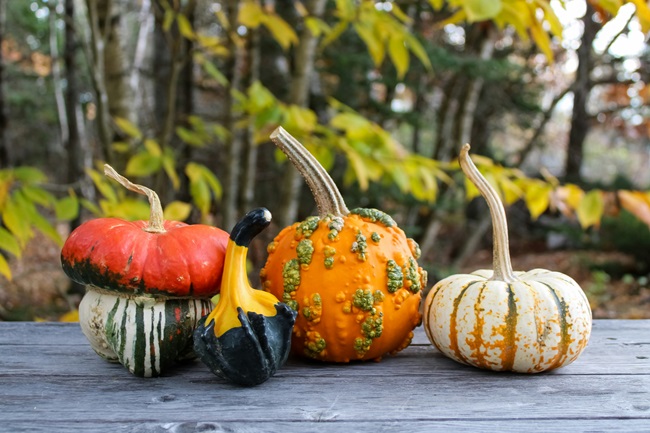
Are you familiar with gourds? The name refers to a wide variety of fruits and vegetables. Well, “vegetable” technically isn’t true. All gourds are actually fruit, as they are formed from an ovary and contain seeds. Knowing this, we will still refer to some gourds as vegetables throughout this article, as that is the common term for them.
So, we’ve discovered that gourds are technically fruits, but practically vegetables. Let’s get more specific now. Gourds refer to the fruit taken from flowering plants in the family Cucurbitaceae which contains 98 genera and about 975 species. This includes gourds that keep the name, like bottle gourds and apple gourds, as well as other vegetables like pumpkins, cucumbers, and squash. There are even traditional fruits in this grouping! Melons like watermelon, honeydew, and cantaloupe are all members of Cucurbitaceae. Finally, some gourds have especially hard shells. These gourds are in a genus called lagenaria, which includes the aforementioned bottle gourd. Once the inside has been removed, the hard shell found in this genus has been repurposed as a water bottle or instrument (think maracas) by humans since early history.
Growing Gourds
When you’re growing gourds, make sure you’re accounting for their long growing season. More common produce like tomatoes and strawberries can be harvested in 70-80 days on average. Gourds routinely take over 100 days to harvest, and it’s not unheard of to take over 120 days. To account for this, make sure that you’re starting seeds inside around 4 weeks before your last frost date.
You’ll also want to ensure that your gourds have a warm growing environment. In the USA, you’ll find gourds grown in southern and southwestern states. Still, gourds are not desert plants. They do not do well in extreme heat and require a steady supply of water to flourish. Gourds, like many plants, thrive in damp soil that is not waterlogged. They especially benefit from liberal amounts of compost and mulch around their growing area. Try to make sure there is at least 4 feet of space (6 feet is ideal) between your gourds to allow room for the vines to spread.
Gourd Use in Human History
After certain types of gourds, like the bottle gourd, are fully mature, the insides can be scooped out and the shell can be repurposed. It’s estimated that humans have been cultivating gourds for over 10,000 years, using them as a source of food and as an accessory for practical, everyday life to rare ceremonies. Here’s a quick list of some of the more noteworthy uses.
- Containers: Tupperware and Hydro Flasks haven’t been around for all of human history. Gourd shells were a convenient way to store harvested grains, spices, and water, especially when you considered that alternative storage containers were hand woven or taken from animals (sheepskin, animal bladders).
- Gourds were part of the first musical instruments ever created. Placing seeds or small stones in a dried gourd creates a simple maraca. A large gourd could be cut open, hollowed out, then covered with an animal skin to create a makeshift drum. Music naturally led to religious ceremonies, where gourds could also contain offerings or be used as a bowl to smoke hallucinogenic herbs.
- Gourds even found a use in fishing! A hollow gourd is naturally buoyant. When attached to the ends of a net, the net will stay afloat in water.
Fun Facts
Interested in learning more about gourds? Get in the fall spirit with some fun facts!
- We just mentioned how gourds are buoyant in the last section, which led to them being used in fishing. However, it’s speculated that the bottle gourd was used to getting wet long before humans got the idea to toss it in a river. The bottle gourd has a very durable shell, which allowed it to drift along ocean currents from Africa to Asia and the Americas long before humans established trading networks.
- While the bottle gourd might be originally from Africa, everyone’s favorite harbinger of fall, the pumpkin, is native to North America. Still, pumpkins are a bit misleading. While we love associating them with fall, the pumpkin is technically a type of winter squash. Today, pumpkins are grown on every continent (with the natural expectation of Antarctica).
- If you were shocked to find out that pumpkins are a winter squash, you’ll be astounded when you realize that jack-o-lanterns were not always associated with pumpkins. Initial jack-o-lanterns were carved in turnips! When Irish immigrants came to America, they found that pumpkins were much easier to work with than turnips, presumably due to the larger surface area of a pumpkin and the harder shell.
- Jack-o-lanterns take their inspiration from the will-o’-the-wisp, a phenomenon that’s both based in reality and folklore. In reality, a will-o’-the-wisp is caused by the oxidization of swamp gases, which can spontaneously combust and emit light. In European folklore, the will-o’-the-wisp is a wayward spirit that imitates a lantern’s light to lead travelers from safe paths to their doom.
- Let’s not forget about the distinctly fruity gourds out there. In Japan, watermelons are often grown in the shape of a cube. While there are some claims that this is the most practical way to grow watermelon floating around the internet, the truth is that this cube shape is just ornamental. In order to maintain its cube shape, a watermelon must be harvested before it is edible. At least it won’t roll off the table when you’re showing it to your friends!


Comment here